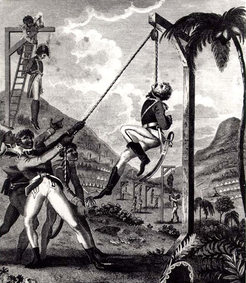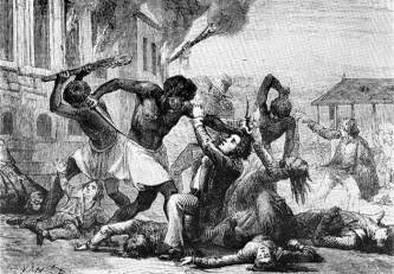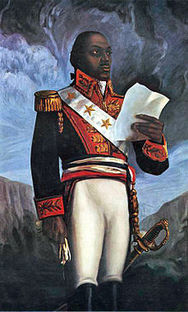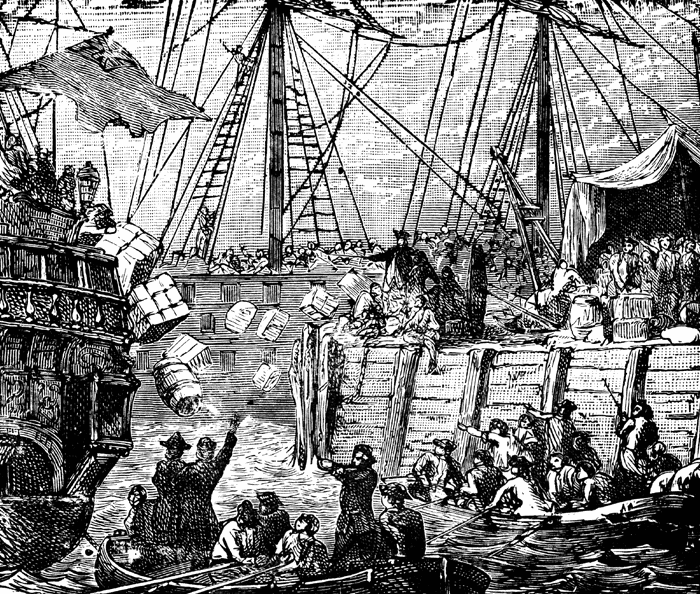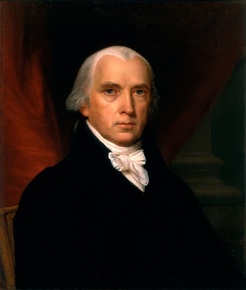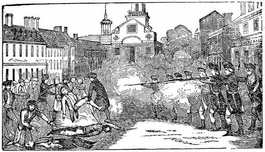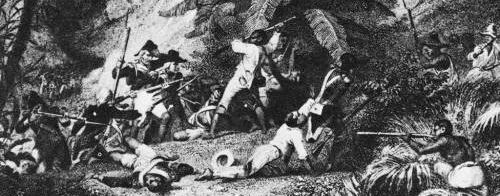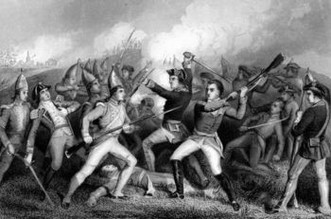Case Study: The Haitian Revolution & The American Revolution
The Haitian Revolution
Beginning in the 1600s, France took control of Haiti as it offered a large economic profit because of its amounts of cocoa, coffee, indigo, cotton and sugar. To increase sugarcane production, in the1730s the French began making irrigation systems. However, this was completely dependent on slave labor. Working conditions were very harsh and the death rate was very high among slaves, so African slaves constantly had to be brought over, making the number of slaves greatly outnumber the masters. Because of this uneven ratio, masters lived in constant fear that a rebellion would occur, so in order to try and maintain order, the masters would brutally treat anyone who tried to escape, didn’t work or was viewed as a potential threat, which only increased thoughts of a rebellion among slaves.
When France published the Declaration of the Rights of Man, white slave owners believed this would allow them more freedom from French control and the ability to create trade regulation that they hoped would increase their wealth and power. Slaves, fearful that their owners would abuse them even more, decided to revolt. In Plaine Du Nord, slaves were separate from the rest of the colony by huge mountains. These slaves, along with slaves from Le Cap, led the rebellion of 1791 against the grands blancs (white colonists). After Dutty Boukman, a voodoo priest, gave a sign to revolt at one of his religious ceremonies, the revolution began and on August 21st, slaves began raping, killing and mutilating their former masters; they also burned more than 180 sugar plantations. By 1792, slaves controlled a third of Haiti. France, wanting to protect its economic interest, decided to grant political rights to free, colored men; they also decided to dispatch 6,000 soldiers to squelch the rebellion once and for all. However, at this time, France decided to declare war on Great Britain. White planters decided to make agreements saying that Britain had sovereignty over the islands and Spain decided to join the conflict and aid the rebels by giving them food, medicine, weapons and support. The French commissioner (Sonthonax), seeing that his French troops were dying, decided to free all slaves in Haiti of his jurisdiction. On February 4th, 1794, the decision was confirmed by the National Convention.
Toussaint L’Ouverture, a former slave, was one of the key players in the Haitian Revolution. L’Ouverture at first fought with Britain and Spain, but then promised to fight for the French if they in return promised to free all the slaves, which they did. He then worked to expel British and Spanish forces. After this, he proclaimed himself governor for life, making the French unhappy so they sent Napoleon Bonaparte to regain control. L’Ouverture was tricked by the French who promised him freedom if he handed over his troops. He did this, but was then sent to a French prison where he died. Once again, Haiti was under French control. However, when Haitians realized the French intended to impose slavery on them again, they chose to revolt in the summer of 1802. French troops were becoming very weak, especially without reinforcements being sent in. France was becoming less concerned with Haiti and increasingly concerned with their major rivals: Prussia, Spain and Great Britain.
On November 18th 1803, Jean Jacques Dessalines led the Battle of Vertieres against the French and on January 1st 1804, Haiti officially gained its independence. Unfortunately, after gaining its independence, Haiti was still devastated by the years it had spent at war. Haiti’s agriculture had been ruined and it had no formal trade. Dessalines, wanting to increase production, decided to make Haiti a serfdom, where everyone was either a worker or soldier. Workers were once again bound to a plantation, but Dessalines did ban the whip in an attempt to make this not look like slavery. Dessalines was also scared France would once again attack, so he built up a huge army. Unfortunately, this greatly hurt production because he took young, strong men away from plantations. Even after long amounts of time passed, Haitian society was still deeply influenced by the patterns that were imposed under the French rule. Despite all this, the Haitian Revolution was a significant moment for Africans in the New World and the only slave revolt that, in the end, led to the founding of a country.
When France published the Declaration of the Rights of Man, white slave owners believed this would allow them more freedom from French control and the ability to create trade regulation that they hoped would increase their wealth and power. Slaves, fearful that their owners would abuse them even more, decided to revolt. In Plaine Du Nord, slaves were separate from the rest of the colony by huge mountains. These slaves, along with slaves from Le Cap, led the rebellion of 1791 against the grands blancs (white colonists). After Dutty Boukman, a voodoo priest, gave a sign to revolt at one of his religious ceremonies, the revolution began and on August 21st, slaves began raping, killing and mutilating their former masters; they also burned more than 180 sugar plantations. By 1792, slaves controlled a third of Haiti. France, wanting to protect its economic interest, decided to grant political rights to free, colored men; they also decided to dispatch 6,000 soldiers to squelch the rebellion once and for all. However, at this time, France decided to declare war on Great Britain. White planters decided to make agreements saying that Britain had sovereignty over the islands and Spain decided to join the conflict and aid the rebels by giving them food, medicine, weapons and support. The French commissioner (Sonthonax), seeing that his French troops were dying, decided to free all slaves in Haiti of his jurisdiction. On February 4th, 1794, the decision was confirmed by the National Convention.
Toussaint L’Ouverture, a former slave, was one of the key players in the Haitian Revolution. L’Ouverture at first fought with Britain and Spain, but then promised to fight for the French if they in return promised to free all the slaves, which they did. He then worked to expel British and Spanish forces. After this, he proclaimed himself governor for life, making the French unhappy so they sent Napoleon Bonaparte to regain control. L’Ouverture was tricked by the French who promised him freedom if he handed over his troops. He did this, but was then sent to a French prison where he died. Once again, Haiti was under French control. However, when Haitians realized the French intended to impose slavery on them again, they chose to revolt in the summer of 1802. French troops were becoming very weak, especially without reinforcements being sent in. France was becoming less concerned with Haiti and increasingly concerned with their major rivals: Prussia, Spain and Great Britain.
On November 18th 1803, Jean Jacques Dessalines led the Battle of Vertieres against the French and on January 1st 1804, Haiti officially gained its independence. Unfortunately, after gaining its independence, Haiti was still devastated by the years it had spent at war. Haiti’s agriculture had been ruined and it had no formal trade. Dessalines, wanting to increase production, decided to make Haiti a serfdom, where everyone was either a worker or soldier. Workers were once again bound to a plantation, but Dessalines did ban the whip in an attempt to make this not look like slavery. Dessalines was also scared France would once again attack, so he built up a huge army. Unfortunately, this greatly hurt production because he took young, strong men away from plantations. Even after long amounts of time passed, Haitian society was still deeply influenced by the patterns that were imposed under the French rule. Despite all this, the Haitian Revolution was a significant moment for Africans in the New World and the only slave revolt that, in the end, led to the founding of a country.
The American Revolution
After the Seven Years’ War came to an end, the British were upset with the high costs and debt they had acquired. Britain decided that to help show their power over the 13 colonies and cover expenses of the war, they would begin imposing legislation and taxes. The colonists strongly opposed Britain’s view that they needed to pay, arguing that without them colonial expansion wouldn’t have been possible. Nonetheless, Britain began imposing taxes and unfair legislation. One of these taxes was the Townshend Act, which taxed a number of essential goods. Angry American colonists decided on March 5th in 1770 to protest. A large group gathered and began throwing rocks and debris at British soldiers. After one soldier fell after being clubbed, the soldiers began firing into the crowd. Although only 5 rebels actually died, this instance became known as the Boston Massacre and was a turning point between the relations of Britain and the 13 colonies. The following year in June 1772, a British ship that was known for unfair trade regulations was burned down by American patriots. This would soon become known as the Gaspee Affair. One year later, on December 16, 1773, rebels snuck aboard the British-East India’s ships and dumped huge amounts of tea into the Boston Harbor; this is now known as the Boston Tea Party. Even more legislation such as the Revenue Act (1764) and the Stamp Act (1765) were passed creating an even greater unrest among the colonists, who argued this legislation was not fair because their interests were not being represented in the English Parliament.
Americans tried to oppose this legislation by creating groups such as the Stamp Act Congress, the Sons of Liberty and, one of the most well-known groups on which both Thomas Jefferson and Patrick Henry served, Virginia’s Committee of Correspondence. All of these groups worked to resist British actions and encouraged Americans to avoid British luxuries and lead simpler lives. While these groups supported patriotism, there was still a large division between the Patriots, those who wanted independence, and the Loyalists, those who still supported British rule.
On April 19, 1775, British troops battled with rebels in what is known as the Battle of Lexington and Concord. In this battle, not only did 400 rebels and British die, but it also marks the official beginning of the American Revolution. Once the news of this battle reached the other colonies, they sent out their forces and the Battle of Bunker Hill followed on June 17, 1775. Although the British technically won this battle, they lost over 1,000 men. Later in 1775, the second Conventional Congress came together to create the Continental Army and attempted to reconcile with Britain. However, Britain refused and sought punishment for rebels.
In March of 1776, with George Washington as commander of the Continental Army, the rebels pushed the British out of Boston. This meant that the rebels now had control of all 13 colonies. By July 1776, even the royal officials had left America. With the help of men like Thomas Jefferson and John Locke, who supported the idea that each person has the right to life, liberty and the pursuit of happiness, the Declaration of Independence was presented to Congress and unanimously adopted on July 4th.
However, following this declaration of a sovereign state, in July 1776 the British defeated the Continental Army at the Battle of Brooklyn and regained control of New York. After a failed attempt at a peace treaty, the British army began pushing the Continental Army farther and farther back. However, there was huge miscommunication on Britain’s side, leading parts of Britain’s military to surrender after they were trapped in Northern New York and forced to surrender at the Battle of Saratoga. This miscommunication also allowed for Washington to lead his troops to rest at Valley Forge.
After the Battle of Saratoga, France decided to formally join the war in support of the colonies and signed the Treaty of Amity and Commerce and the Treaty of Alliance. Spain and the Dutch later joined the French in supporting the colonies and weakening the British forces. In 1781, when the British finally marched to Yorktown, there was a large French fleet awaiting them. The British had also abandoned some of their forces in New York. This left them no option but to surrender. Soon after in 1783, the Treaty of Paris was signed which gave the US all land East of the Mississippi River and South of the Great Lakes.
After the war ended in 1783, the states were under the Articles of Confederation and although this worked for some time, there were major flaws including a lack of a strong central authority. These flaws eventually spurred a new Constitution to be created which was ratified on June 21, 1788. This new Constitution was due primarily to the ideas of James Madison and his strong belief in peoples' rights.
Americans tried to oppose this legislation by creating groups such as the Stamp Act Congress, the Sons of Liberty and, one of the most well-known groups on which both Thomas Jefferson and Patrick Henry served, Virginia’s Committee of Correspondence. All of these groups worked to resist British actions and encouraged Americans to avoid British luxuries and lead simpler lives. While these groups supported patriotism, there was still a large division between the Patriots, those who wanted independence, and the Loyalists, those who still supported British rule.
On April 19, 1775, British troops battled with rebels in what is known as the Battle of Lexington and Concord. In this battle, not only did 400 rebels and British die, but it also marks the official beginning of the American Revolution. Once the news of this battle reached the other colonies, they sent out their forces and the Battle of Bunker Hill followed on June 17, 1775. Although the British technically won this battle, they lost over 1,000 men. Later in 1775, the second Conventional Congress came together to create the Continental Army and attempted to reconcile with Britain. However, Britain refused and sought punishment for rebels.
In March of 1776, with George Washington as commander of the Continental Army, the rebels pushed the British out of Boston. This meant that the rebels now had control of all 13 colonies. By July 1776, even the royal officials had left America. With the help of men like Thomas Jefferson and John Locke, who supported the idea that each person has the right to life, liberty and the pursuit of happiness, the Declaration of Independence was presented to Congress and unanimously adopted on July 4th.
However, following this declaration of a sovereign state, in July 1776 the British defeated the Continental Army at the Battle of Brooklyn and regained control of New York. After a failed attempt at a peace treaty, the British army began pushing the Continental Army farther and farther back. However, there was huge miscommunication on Britain’s side, leading parts of Britain’s military to surrender after they were trapped in Northern New York and forced to surrender at the Battle of Saratoga. This miscommunication also allowed for Washington to lead his troops to rest at Valley Forge.
After the Battle of Saratoga, France decided to formally join the war in support of the colonies and signed the Treaty of Amity and Commerce and the Treaty of Alliance. Spain and the Dutch later joined the French in supporting the colonies and weakening the British forces. In 1781, when the British finally marched to Yorktown, there was a large French fleet awaiting them. The British had also abandoned some of their forces in New York. This left them no option but to surrender. Soon after in 1783, the Treaty of Paris was signed which gave the US all land East of the Mississippi River and South of the Great Lakes.
After the war ended in 1783, the states were under the Articles of Confederation and although this worked for some time, there were major flaws including a lack of a strong central authority. These flaws eventually spurred a new Constitution to be created which was ratified on June 21, 1788. This new Constitution was due primarily to the ideas of James Madison and his strong belief in peoples' rights.
Similarities & Differences
While there were varying degrees of success between the American Revolution and the Haitian Revolution, both of these revolts were successful in gaining independence from a European super power prior to the 19th Century. The Haitian Revolution was a sign of liberty for other countries, so much so that the US banned the importing of Haitian slaves because they were afraid a rebellion might occur if slaves were given any thoughts of liberty from the Haitians. While the American Revolution focused on bringing more equality and freedom to the middle class, the Haitian Revolution was very much focused on bringing freedom to everyone: the gens de couleur (mulattoes) and the African-born slaves. Haiti and America also differed in their military because while Haiti had a very large army to protect from any future attacks from France, under the Articles of Confederation, the US Congress could not draft troops and thus was completely dependent on the states. However, despite these differences, both America and Haiti struggled after their revolutions ended. Haiti was devastated after years of conflict and faced huge economic problems because they lacked trade with other nations. Adding to Haiti’s unstable financial start was the fact that Haiti was “mortgaged to French banks in the 1820s” because it was forced to “pay reparations to French slaveholders so that Haiti could gain French recognition and end its economical and political isolation.” America was also in great debt after the revolution. This was eventually solved when America set up a three branch government with checks and balances so that each branch was holding the other accountable while they payed off their debt slowly by creating two issues of paper money and eventually having the French supply them with money and gunpowder in the hopes of weakening Great Britain. While Haiti eventually set up a semi-presidential Republic, there were little to no checks and balances on power so there was much political corruption, leading Haiti to become the poorest country in the Western Hemisphere.
Works Cited
"The American Revolution -
(Home)." The American Revolution - (Home). N.p., n.d. Web. 29 Mar.
2013. <http://www.theamericanrevolution.org/default.aspx>.
"American Revolution." Wikipedia. Wikimedia Foundation, 29 Mar. 2013. Web. 29 Mar. 2013. <http://en.wikipedia.org/wiki/American_Revolution>.
"American vs Hatian Revolution." - Research Papers. Studymode, Jan. 2012. Web. 29 Mar. 2013. <http://www.studymode.com/essays/American-Vs-Hatian-Revolution-900895.html>.
"Articles of Confederation vs. the Constitution." Articles of Confederation vs. the Constitution. N.p., n.d. Web. 29 Mar. 2013. <http://home.earthlink.net/~gfeldmeth/chart.art.html>.
"Haiti." Wikipedia. Wikimedia Foundation, 29 Mar. 2013. Web. 29 Mar. 2013. <http://en.wikipedia.org/wiki/Haiti>.
"Haitian Revolution." Wikipedia. Wikimedia Foundation, 29 Mar. 2013. Web. 29 Mar. 2013. <http://en.wikipedia.org/wiki/Haitian_Revolution>.
"Slavery and the French Revolution." HistoryWiz. N.p., 2008. Web. 29 Mar. 2013. <http://www.historywiz.com/slavery-frenchrev.htm>.
"American Revolution." Wikipedia. Wikimedia Foundation, 29 Mar. 2013. Web. 29 Mar. 2013. <http://en.wikipedia.org/wiki/American_Revolution>.
"American vs Hatian Revolution." - Research Papers. Studymode, Jan. 2012. Web. 29 Mar. 2013. <http://www.studymode.com/essays/American-Vs-Hatian-Revolution-900895.html>.
"Articles of Confederation vs. the Constitution." Articles of Confederation vs. the Constitution. N.p., n.d. Web. 29 Mar. 2013. <http://home.earthlink.net/~gfeldmeth/chart.art.html>.
"Haiti." Wikipedia. Wikimedia Foundation, 29 Mar. 2013. Web. 29 Mar. 2013. <http://en.wikipedia.org/wiki/Haiti>.
"Haitian Revolution." Wikipedia. Wikimedia Foundation, 29 Mar. 2013. Web. 29 Mar. 2013. <http://en.wikipedia.org/wiki/Haitian_Revolution>.
"Slavery and the French Revolution." HistoryWiz. N.p., 2008. Web. 29 Mar. 2013. <http://www.historywiz.com/slavery-frenchrev.htm>.
